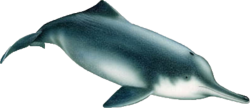River dolphin
| River Dolphins | ||||||||||||
|---|---|---|---|---|---|---|---|---|---|---|---|---|
 |
||||||||||||
| Scientific classification | ||||||||||||
|
||||||||||||
| Families | ||||||||||||
River dolphins are four living species of dolphin which reside in freshwater rivers and estuaries. They are classed in the Platanistoidea superfamily of cetaceans. Three species live in fresh water rivers. The fourth species, the La Plata Dolphin, lives in salt-water estuaries and near-shore marine environments. However, it is scientifically classed in the river dolphin family rather than the oceanic dolphin family.
Contents |
Ecology
River dolphins are now facing extinction due to habitat loss, hunting by humans, and naturally low numbers. Also, many river dolphins possess very poor eyesight -- some are considered blind -- which can lead to unfortunate encounters with humans or human-made objects (boats or fishing nets, for example).
Taxonomy
In the most recent classification (Rice, 1998) there are currently four extant families that make up the river dolphins. However, a December 2006 survey found no members of Lipotidae (commonly known as the Yangtze River dolphin) and declared the species functionally extinct[1][2], Platanistidae is listed as the only extant family of the Platanistoidea superfamily. The previously accepted classification treated all four families as belonging to this family and treated the Ganges and Indus River Dolphins as separate species. Five lineages of dolphin have evolved to live in big, muddy rivers. River dolphins are though to have relictual distributions. Their ancestors originally occupied marine habitats, but were then displaced from these habitats by modern dolphin lineages.[3][4] Many of the morphological similarities and adaptations to freshwater habitats arose due to convergent evolution.
Classification by Rice (1998)
- Superfamily Platanistoidea
- Family Platanistidae
- Ganges and Indus River Dolphin, Platanista gangetica with two subspecies
- Ganges River Dolphin (or Susu), Platanista gangetica gangetica
- Indus River Dolphin (or Bhulan), Platanista gangetica minor
- Ganges and Indus River Dolphin, Platanista gangetica with two subspecies
- Family Iniidae
- Amazon River Dolphin (or Boto), Inia geoffrensis
- Family Lipotidae
- Chinese River Dolphin (or Baiji), Lipotes vexillifer (possibly extinct, since December 2006)
- Family Pontoporiidae
- La Plata Dolphin (or Franciscana), Pontoporia blainvillei
- Family Platanistidae
Previous classification
- Family Platanistidae
- Ganges River Dolphin (or Susu), Platanista gangetica
- Indus River Dolphin (or Bhulan), Platanista minor
- Amazon River Dolphin (or Boto), Inia geoffrensis
- Chinese River Dolphin (or Baiji), Lipotes vexillifer (presumed extinct as of 2006)
- La Plata Dolphin (or Franciscana), Pontoporia blainvillei
Extinction
On Dec. 13th, 2006, the Yangtze River Dolphin, or Baiji, was declared "functionally extinct", after a 45-day search by leading experts in the field failed to find a single specimen [1][1]. The last verified sighting of the beak-nosed dolphin was in September of 2004 [2]. However, in August, 2007, reports surfaced that a man saw and videotaped what appears to be a baiji in the Yangtze River. A team of scientists attempted to verify the sighting beginning in September, 2007 [3].
It is believed that overfishing, damming and sub-aquatic sonar pollution (which interfered with the dolphin's sonar-based method of locating food), led to the extinction. Reuters news reported this their first record of a mammalian extinction in 50 years.
Notes
- ↑ 1.0 1.1 Turvey, S. T., R. L. Pitman, B. L. Taylor, J. Barlow, T. Akamatsu, L. A. Barrett, X. Zhao, R. R. Reeves, B. S. Stewart, K. Wang, Z. Wei, X. Zhang, L. T. Pusser, M. Richlen, J. R. Brandon and D. Wang (2007). "First human-caused extinction of a cetacean species?". Journal of the Royal Society, Biology Letters 3: 537-540. doi:.
- ↑ All Headline News, Dec. 2006.
- ↑ Cassens, I., S. Vicario, V. G. Waddell, H. Balchowsky, D. Van Belle, W. Ding, C. Fan, R. S. L. Mohan, P. C. Simoes-Lopes, R. Bastida, A. Meyer, M. J. Stanhope, and M. C. Milinkovitch (2000). "Independent adaptation to riverine habitats allowed survival of ancient cetacean lineages". Proceedings of the National Academy of Sciences of the United States of America 97: 11343-11347. doi:.
- ↑ Hamilton, H., S. Caballero, A. G. Collins, and R. L. Brownell Jr. (2001). "Evolution of river dolphins". Proceedings of the Royal Society of London Series B: Biological Sciences 268: 549-556. doi:.
References
- Reeves, Randall R. et al. (2002). National Audubon Society guide to marine mammals of the world. Alfred A. Knopf. 527 pp.
- Rice, Dale W. (1998). Marine mammals of the world: systematics and distribution. Society of Marine Mammalogy Special Publication Number 4. 231 pp.
|
||||||||||||||||||||||||||||||||||||||||||||||||||||||||||||||||||||||||||||||||||||||||||||||||||||||||||||||||||||||||||||||||||||||||||||||||||||||||||||||||||||||||||||||